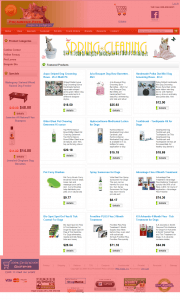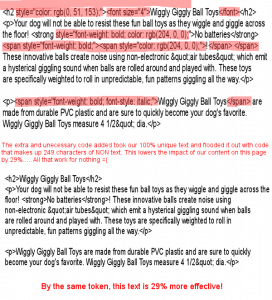Google’s recent changes, while in some cases overly aggressive have all been about removing low quality and spammy content from their results. I can certainly appreciate that as, like you, I am a searcher as well. I would like to say that searches are better now than they were a few months ago… But that would be a lie. So logically speaking, we can expect more of the same from Google until they get it right.
Every shop owner should be taking steps to eliminate low quality content, duplication and improper formed content throughout your websites. No one expects to complete this in a day, to be honest I have a couple of days to spend in my own shops and we have never duplicated content EVER. So, do not think you are going to be “okay”, rather take the steps to update your content and store’s SEO now while Google is still experimenting.
First let me start by saying I mention SEO in the truest sense of the process and not in the manner most of you *think SEO is about. SEO is very simply managing the website’s ability to be properly crawled and indexed by search engines. Notice the complete and utter lack of words like keywords, stuffing, spam, tags…etc. That’s simply because that stuff is garbage marketing and NOT SEO.
While just like anything else new, there is a lot involved… We are going to concentrate on 3 main areas that ecommerce shop owners can should be able to control. These areas are duplication, quality and architecture. I’ve decided that these areas are likely to provide the greatest impact for shop owners and help you to create better habits ongoing as well.
Duplication
Duplication of content can happen in may ways and comes in many forms. For ecommerce websites we will canonical duplication, copied text, lack of text and repeated text as the top areas of concern.
Canonical duplication:
This is simply the duplication caused by the same content being loaded on more than one url. For example www.domain.com, domain.com, domain.com/index.php?main_page=index etc… you get the picture. Serving up the correct canonical page for your content is crucial and this is a task that is easily met. For your www/non www provide a 301 permanent redirect to the correct version. For the index pages, provide a 301 permanent redirect to the domain/shop root such as domain.com. We specialize in Zen Carts, so we can provide some extra tips for not so normal canonical duplication such as /index.php?main_page=products_new and /index.php?main_page=products_new&disp_order=6&page=2 for example. The issue with new products, specials, featured and even sorted product index pages is that they have the same content, but different urls. The easiest way to combat this is to upgrade to Zen Cart version 1.3.9H, which has native canonical support via the rel=”canonical” tags for these and other pages.
Copied Text:
Copied text is just that… If you copied the text in full or part from ANY other web page (including your own), it’s duplicate. This also includes using manufacturer’s provided descriptions that 9 million other shops are using as well. The simplest way to fix this issue is to “stem” the content. If you add or change a word every 5 words, the content should then be unique to you.
Lack of Text:
This one is a little more confusing. The most common cause (see image below) is that shop owners do not provide enough page unique text to overcome the common template textual areas which are duplicate on every page.

While I am in no way suggesting that a common template throughout your website is a bad thing…. Quite the contrary as it’s more professional, consistently branded and builds shoppers trust. Rather I am suggesting that the page specific text on each be of enough content to make the page about the unique provided text.
Quality of Textual Content
This one in my opinion is the easiest to figure out and perhaps the most tedious to implement. Writing unique and quality content is your job if you have a website… No ifs ands or buts about it. It is necessary and it’s a load of long hard work to accomplish once you already derailed.
Your product descriptions for example should be descriptive, creative and moving. I tell shop owners to describe and sell the product on the page the exact same way they would on the phone. Category pages and index pages are a bit more of a struggle. We know we need unique content… But we are concerned with the page real estate issues of our product listings being pushed down the page. With these pages I have 3 simple rules.
1. The text is ONLY about that page and no other pages or broad site comments.
2. The text is 100% unique.
3. The text is short enough to allow the shopper to at least get the first product listing without scrolling.
Proper Textual Architecture
As we have discussed already, Google endeavors to more effectively determine the proper “weight” for our web page containers. This in a great many ways will help shop owners. The common template text we discussed earlier will have it’s weight “downgraded” by Google, logically making our unique text in the “main content container” more effective. But this idea has some other implications as well with regard to how we form our content.
Content should be formed in proper containers. Paragraphs, lists and other “grammar school day lessons” will be need to be practiced so that Google can effectively segment the page’s containers, thoughts and more effectively pull snippets. These are a challenge for many and the code aspect is a real challenge for all Zen Cart HTML editors. The built in editor tends to screw this all up. Instead of a clean separation of content with <p> paragraph tags we tend to see….
<p>some text is here and this is the thought<br /><br />this is the next thought but the editor is too stupid to create another paragraph</p>
I will suggest that you use a proper HTML editor to create proper containers for your text and avoid using Zen Cart built in editors at all. Something we didn’t mention above is the code/text ratio of a page. This is a little more complicated than I wanted to go, but I will touch on it briefly.
Let’s say for example you edit a product description using a built in editor and change some size, colors etc. See example of the damage all the garbage code can cause below.

I’ll leave you all to get to work now…. As always if you have any questions, we will be sure to help you out best we can.
